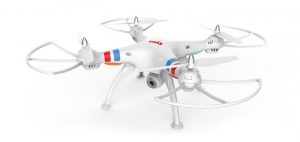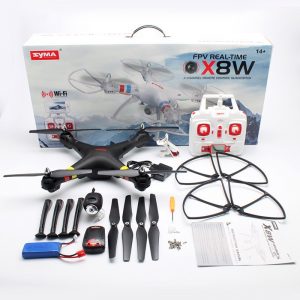Last month, I reviewed the Syma X8C — a 350-size toy-grade quadcopter by Syma which also happens to be the company’s largest model to date. Like the smaller X5C-1, the X8C is amazingly stable in the air and is great fun to fly. It also offers great value for money, costing less than $100.
With a diagonal motor size of 350mm, the X8C mimicked the flight performance of more expensive drones such as the Phantom 3 thanks to its large coreless motors which provide a lot of power. It is a great way to get the feel of flying more expensive $1,000 drones without splashing too much money.
But there is one thing that’s missing from the X8C spec sheet — FPV (First Person View). The X8C comes with a 2MP camera that take decent videos and photos but lacks the feature to transmit live video feed to the operator on the ground. This means aligning shots while taking videos or photos is a hit-and-miss affair.
The Syma X8W (foreground) and the X8C are identical with the exception of their cameras.
Enter the new Syma X8W — the FPV version of the X8C. The X8W comes with all the goodness you get in the X8C with FPV thrown into the mix. In fact, the X8W is actually the exact same quadcopter as the X8C. The only difference is it comes with a camera that is capable of transmitting FPV video over wifi making the X8W the most advanced 350-size toy-grade quadcopter in Syma’s fleet.
The Syma X8W (left) and X8C (right).
Since I have already done an in-depth review of the X8C, this review will focus mainly on the FPV feature of the X8W. To read more about how the X8C flies and performs, click here for the in-depth review.
Specifications
- Dimensions: 50 x 50 x 19cm (with prop guards)
- Diagonal motor distance: 350mm
- Motor size: 15mm coreless
- Weight: Approx 598g (with battery, camera and prop guards)
- Flight time:
- 9 to 12 minutes (with camera turned on, no prop guards)
- Battery: 7.4V 2000mAh 25C Li Po
- Charging time: 200 minutes
- Control distance: approximately 100m
- Transmitter power: 4 x 1.5V AA batteries (not included)
FPV
Syma took the same approach as it did with the X5SW in applying FPV to the X8W. This means the camera on the X8W is actually the same one on the X8C with the added ability to transmit FPV video over wifi. Both X8W and X8C cameras are nearly identical with the exception of the wifi antenna sticking out from the rear of the X8W camera.
When the X8W is turned on, the camera immediately sets up its own unprotected wifi hotspot and takes roughly 20 seconds to do this. Once the hotspot is up, all you need to do to view the FPV feed is to connect your smartphone to the wifi hotspot and then launch the Syma FPV app which is available for both Android and iOS.
Syma has also included a smartphone holder so you can mount your smartphone at the top of the transmitter for easy viewing.
FPV on the X8W isn’t exactly a painless experience. Although it is pretty straightforward and easy to set up, the feed suffers from high latency which means the X8W cannot be flown entirely on FPV. For this reason, the X8W must always be flown within line of sight.
Latency is lowest when the X8W is within several meters of your smartphone and increases as it goes further away or when there are walls or large objects in between the quad and phone. It gets particularly bad at distances of 50 meters or more. At such distances, the FPV feed is reduced to a slideshow of images that refreshes itself every one or two seconds.
This latency problem is a hallmark of any FPV system that transmits via wifi and is in no way comparable to proper transmission frequencies such as 5.8GHz or DJI’s Lightbridge.
However, when you consider that the X8W costs roughly $100, you can forgive it for its poor FPV performance. With such an affordable price tag, the X8W costs only a fraction of drones that have proper FPV systems and is a great option for beginners who want to get acquainted with FPV.
Although you can’t properly fly it using FPV, the video feed can still allow you to effectively frame your shots and give you an idea what the camera is seeing.
Photos and videos are not saved on the camera itself. Instead they are saved on your smartphone via the Syma FPV app. This is both good and bad. Good because smartphones generally have more storage space than most memory cards supplied with toy-grade quadcopters and they are also a safer and more convenient way to store your files. Bad because the app will just record everything it receives from the camera. This includes video that has been affected by poor latency in transmission which often results in videos that look like slideshows.
As with the X8C, the image quality from the X8W’s camera is decent enough for a $100 toy-grade quadcopter. However, the X8C is not an aerial photography platform that you’d use for a professional video production. It is meant for beginners who want an affordable introduction to the world of FPV.
Flight Time
The X8C has some really decent flight times, thanks to its massive 2000mAh battery. Without prop guards, the X8W can fly for approximately 11 minutes in moderate winds with its camera turned on.
The supplied 2000mAh battery provides some really impressive flight times.
One strange thing I’ve observed is that the X8W’s flight time remains very much the same with or without its camera. Without the camera drawing power for its wifi hotspot, one would expect the power consumption to be lower resulting in longer flights but this is not the case with the X8W. The X8W can fly for about 9 to 11 minutes, irrespective of whether you have the camera attached or not.
In one test flight, the X8W flew for about 11 minutes in moderate winds with its camera turned on in outdoor temperatures of over 30C. In another two subsequent flights, it flew approximately 10 minutes without its camera in calm weather with temperatures below 30C. In all test flights, prop guards were removed.
Conclusion
With a price tag of $100, the X8W is aimed squarely at beginners who are keen to experience FPV flying on a tight budget. It also inherits all the strengths of its non-FPV sibling — the X8C. This includes a highly stable flight behavior, decent build quality, good stability in windy conditions and also decent flight times.

While its camera provides some decent images and video for the price, it also suffers from high latency. This means it is not possible to fly the X8W entirely using FPV and the drone must always be kept within line of sight when flying. Like the smaller X5SW, videos and photos taken with the X8W is recorded on your smartphone instead of a memory card on the camera. This method has both pros and cons, as mentioned earlier, and may sometimes result in video recordings that capture the latency problem of the camera’s wifi transmission.

Despite lackluster FPV performance, the X8W is still an excellent option if you want to experience FPV flying but are not willing to splash big money on a good FPV drone. At just $100, what can possibly go wrong? Not only is the X8W a great beginner drone for aerial photography, it also makes a good trainer drone. With its decent flight times, great price, good build quality and stable flight, this is one toy-grade quadcopter that I’d highly recommend to anyone looking for a decent beginner drone.